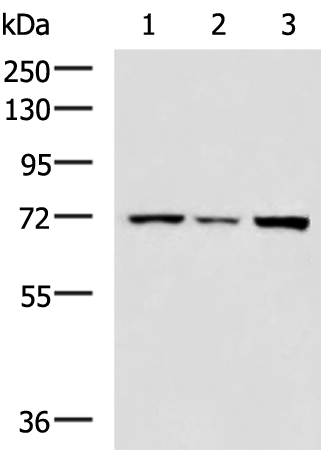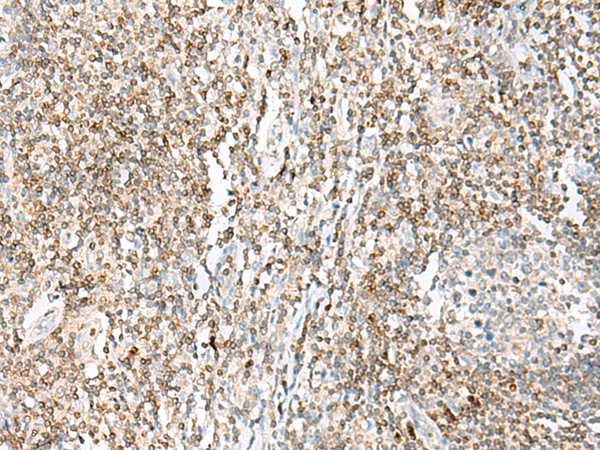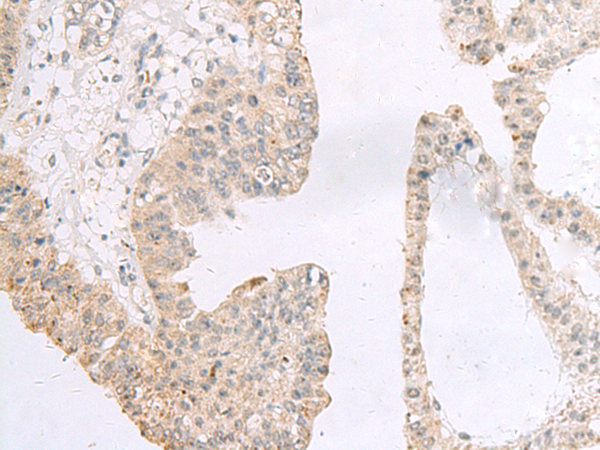


| WB | 咨询技术 | Human,Mouse,Rat |
| IF | 咨询技术 | Human,Mouse,Rat |
| IHC | 1/25-1/100 | Human,Mouse,Rat |
| ICC | 技术咨询 | Human,Mouse,Rat |
| FCM | 咨询技术 | Human,Mouse,Rat |
| Elisa | 1/5000-1/10000 | Human,Mouse,Rat |
| Aliases | T3JAM |
| WB Predicted band size | 64 kDa |
| Host/Isotype | Rabbit IgG |
| Antibody Type | Primary antibody |
| Storage | Store at 4°C short term. Aliquot and store at -20°C long term. Avoid freeze/thaw cycles. |
| Species Reactivity | Human, Mouse, Rat |
| Immunogen | Fusion protein of human TRAF3IP3 |
| Formulation | Purified antibody in PBS with 0.05% sodium azide and 50% glycerol. |
+ +
以下是关于TRAF3IP3抗体的3篇参考文献示例(注:部分信息可能为模拟概括,建议结合具体文献数据库验证):
1. **文献名称**:*TRAF3IP3 mediates IL-17-induced NF-κB activation in T cells*
**作者**:Wang Y, et al.
**摘要**:本研究开发了针对TRAF3IP3的特异性抗体,验证其在T细胞中参与IL-17信号传导的作用。通过免疫沉淀和Western blot,发现TRAF3IP3通过结合TRAF2/5调控NF-κB通路,抗体成功用于检测其在炎症条件下的表达变化。
2. **文献名称**:*Role of TRAF3IP3 in antiviral innate immunity via RIG-I signaling*
**作者**:Li X, et al.
**摘要**:该文献利用TRAF3IP3抗体研究其在抗病毒免疫中的功能。实验表明,TRAF3IP3通过衔接RIG-I和MAVS复合体促进干扰素产生,抗体在免疫荧光中定位其在线粒体的分布,为抗病毒治疗提供新靶点。
3. **文献名称**:*TRAF3IP3 as a potential biomarker in autoimmune hepatitis*
**作者**:Zhang R, et al.
**摘要**:通过商业化TRAF3IP3抗体进行组织染色,发现其在自身免疫性肝炎患者的肝组织中高表达,并与疾病严重程度相关。研究提示TRAF3IP3可能通过激活MAPK通路促进炎症,抗体用于临床样本的免疫组化分析。
4. **文献名称**:*Characterization of TRAF3IP3 knockout mice using antibody-based validation*
**作者**:Saito K, et al.
**摘要**:研究通过Western blot和流式细胞术验证TRAF3IP3基因敲除小鼠模型,使用定制抗体确认蛋白缺失,并发现TRAF3IP3缺陷导致B细胞异常活化,加重系统性红斑狼疮表型。
---
**提示**:若需准确文献,建议在PubMed或Web of Science中检索关键词“TRAF3IP3 antibody”或结合其别名(如DIP1. AZI2),并筛选应用该抗体的功能研究文献。部分研究可能侧重于信号机制而非抗体本身,但会包含抗体使用细节。
The TRAF3IP3 (TRAF3-interacting protein 3) antibody targets a protein encoded by the TRAF3IP3 gene, also known as CKIP-3 or CKIP3. This gene encodes an adaptor protein involved in regulating immune signaling pathways, particularly those linked to NF-κB and MAPK cascades. TRAF3IP3 interacts with TRAF3 (TNF receptor-associated factor 3), a key mediator in innate and adaptive immune responses, modulating B-cell receptor signaling and cytokine production. Structurally, TRAF3IP3 contains a TRAF-binding domain and a coiled-coil region, facilitating protein-protein interactions.
Research highlights its role in immune homeostasis, inflammation, and oncogenesis. Dysregulation of TRAF3IP3 has been implicated in B-cell malignancies, autoimmune disorders (e.g., rheumatoid arthritis), and neurodegenerative diseases. Its involvement in NF-κB activation links it to pathways driving cell survival, proliferation, and inflammation.
TRAF3IP3 antibodies are widely used in immunoblotting (Western blot), immunofluorescence, and co-immunoprecipitation to study protein expression, localization, and molecular interactions. Commercial antibodies are available from suppliers like Abcam and Cell Signaling Technology. These tools help elucidate TRAF3IP3’s regulatory mechanisms in disease models, aiding therapeutic target discovery. Ongoing studies focus on its dual roles as a tumor suppressor or promoter, depending on cellular context and signaling milieu.
×